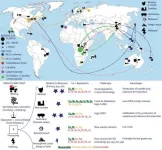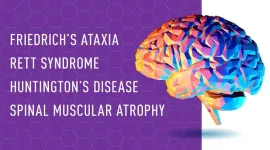(Press-News.org) A new virtual ward to safely treat atrial fibrillation patients could prevent thousands of hospital admissions per year, easing NHS pressure, according to new research from the University of Leicester presented at the British Cardiovascular Society (BCS) conference in Manchester.
In the year-long study, patients with a fast heart rate due to atrial fibrillation or atrial flutter that met the necessary safety criteria(1) were sent home with the heart rate-lowering medication they would usually get in hospital, and told to submit daily information using a smartphone app.
Their data, including ECG recordings, blood pressure, oxygen saturation and answers to an atrial fibrillation symptom questionnaire, were closely monitored by specialist doctors and nurses at Glenfield Hospital in Leicester, who made treatment decisions remotely.
The conventional arrangement involves patients being monitored for several days in hospital, adding to the ongoing pressure on the NHS.
Atrial fibrillation is the most common form of abnormal heart rhythm and is believed to contribute to one in five strokes. One in 45 people in the UK are known to be living with the condition.
Professor André Ng, Professor of Cardiac Electrophysiology and Head of Department of Cardiovascular Sciences at the University of Leicester, said:
“By using the data patients collect to make treatment decisions on a day-to-day basis, this virtual ward is not simply monitoring patients. It is delivering hospital level care for patients in the comfort of their own home.
”This is a great opportunity to prevent thousands of hospital admissions each year before they’ve even begun, saving the NHS precious time and money when it needs it most.“
During the single-hospital trial between January 2022 and January 2023 there were 118 virtual admissions, 66 of which (55 per cent) were ‘step-up‘, where the virtual ward was used instead of hospital admission. The other 45 per cent were ‘step-across‘, where early hospital discharge was possible thanks to the virtual ward.
As well as 66 ‘step-up‘ admissions, 61 re-admissions to hospital were safely stopped, meaning that 127 unplanned hospitalisations were prevented. This saved an estimated 444 days in hospital for patients.
The findings also showed the average heart rate reduced from 124 bpm at when patients were admitted to the virtual ward to 84 bpm when they were discharged. The clinical team also developed and used e-pharmacy measures to ensure they could change patients‘ prescriptions quickly if needed.
Professor Sir Nilesh Samani, Medical Director at the British Heart Foundation, said:
“We’ve seen time and time again how the pressure on the NHS is compromising heart and circulatory disease care, with constant shortages of hospital beds and long waiting lists for treatments. This trial shows that we can use the latest healthcare technology to ease this pressure and free up space.
“The positive treatment outcomes and high patient satisfaction seen in this study show that we don’t have to make compromises when saving time and money on atrial fibrillation treatment. The same approach may be possible and is already being trialled for other heart conditions such as heart failure.“
These results are being presented at the BCS conference by research fellow Dr Ahmed Kotb and advanced nurse practitioner Sue Armstrong.
The researchers now plan to use new funding from the British Heart Foundation (BHF) to scope out the implementation of the virtual ward beyond Leicester to several other NHS England centres, continuing to test the strategy before it is rolled out across the whole NHS.
END
Virtual ward for atrial fibrillation patients could prevent thousands of hospital admissions per year
2023-06-07
ELSE PRESS RELEASES FROM THIS DATE:
Daily beetroot juice reduces rate of repeat procedures and heart attacks in angina patients with stents
2023-06-07
Drinking beetroot juice every day for six months after having a stent fitted reduced the chance of angina patients having a heart attack or needing a repeat procedure, according to new research presented at the British Cardiovascular Society conference.
The finding on the benefits of the vegetable juice comes from a trial funded by the National Institute for Health and Care Research and the British Heart Foundation (BHF), presented at the conference in Manchester.
The researchers, based at St Bartholomew’s Hospital and Queen Mary University ...
Knowledge coproduction: Working together to solve a complex conservation problem
2023-06-07
A new publication from a team of scientists at USGS, Point Blue Conservation Science, and Conservation Biology Institute shows how knowledge coproduction - the collaborative creation of actionable information by scientists, resource managers, and policy makers - can help identify viable conservation options for a dynamic ecosystem with a complex web of stressors.
The wetland habitats of California’s Central Valley support millions of migratory birds each year and are an important part of the Pacific Flyway, a bird migration route that ...
UW research shows real-world value of strategy courses for MBA students
2023-06-07
More than 100,000 Master of Business Administration students graduate each year in the United States, and all of them take at least one strategy course. Even so, little is known about the effects of the degree’s most popular course offering.
Strategy courses typically focus on frameworks and cases that develop decision-making abilities for eventual MBA graduates, who make up most associates and partners at leading consulting firms, as well as 40% of the chief executive officers of publicly traded firms in the U.S. A new University of Washington study, published online June 5 ...
Measuring greenhouse gas from ponds improves climate predictions
2023-06-06
ITHACA, N.Y. – Shallow lakes and ponds emit significant amounts of greenhouse gases into the atmosphere, but emissions from these systems vary considerably and are not well understood.
Now, a new Cornell University-led study measures methane and carbon dioxide emissions from 30 small lakes and ponds (one acre or less) in temperate areas of Europe and North America, revealing that the smallest and shallowest bodies of water exhibit the greatest variability over time.
The paper marks an important step toward calibrating climate models so they better predict emissions from inland waterbodies, and it points to the need to study small waterbodies more closely.
“This ...
Cobalt mineralogy at the Iron Creek deposit, Idaho cobalt belt, USA: Implications for domestic critical mineral production
2023-06-06
Contributed by Laura Fattaruso, GSA Science Communication Fellow
Boulder, Colo., USA: A new study published in Geology evaluates the potential for cobalt extraction from the Idaho Cobalt Belt (ICB) of east-central Idaho, using a detailed study of the Iron Creek deposit. The ICB hosts the second largest known domestic resource of the critical mineral cobalt, one of the key ingredients in many rechargeable batteries needed for the green energy transition. Demand for cobalt is projected to increase more than 500% by 2050. Roughly 70% of the cobalt mined globally is from the Democratic Republic of the Congo, where mining practices have been criticized for human rights violations including ...
Predictive models show wildlife managers where to find destructive feral swine
2023-06-06
UNIVERSITY PARK, Pa. — Feral swine are considered one of the top invasive species of concern in North America because of the damage they do to agricultural and natural systems. To best manage them, resource management agencies need to know more precisely where and when to implement control methods. A new study by a Penn State-led research team developed a method to help guide control efforts in the Great Smoky Mountains National Park.
Descended from wild European boars imported centuries ago that bred with escaped domestic pigs, feral swine cause widespread damage to ecosystems by wallowing ...
Revolutionizing optical control with topological edge states
2023-06-06
Nanophotonics and topology have gained significant interest due to the unique properties they offer. One area of focus is the investigation of topological edge states (TESs). These states have captured widespread attention because they are very resistant to errors and imperfections. Arising from topologically nontrivial phases, TESs provide a powerful toolkit for the architectural design of photonic integrated circuits. TES transport has led to the discovery of various intriguing optical effects and applications, including directional couplers, one-way waveguides, mode-locked waveguides, ...
Research to develop new rare disease therapies underway at The Jackson Laboratory
2023-06-06
Researchers led by Cathleen Lutz, Ph.D., are using an exciting new method, preclinical genomic editing, to develop safe, effective therapies for rare diseases and bring them to the clinic.
Unfortunately, the translation of the accumulated knowledge to safe and effective therapies has lagged. There are many reasons to predict that the situation is changing for the better, however, as powerful new gene-based therapies succeed in clinical trials and receive FDA approval.
Therapeutic strategies such as gene replacement and gene modulation (e.g., blocking protein production with anti-sense oligonucleotides) are at the forefront of the recent progress. ...
Elizabeth Anderson and Alondra Nelson win 2023 Sage-CASBS Award
2023-06-06
Sage and the Center for Advanced Study in the Behavioral Sciences (CASBS) at Stanford University are pleased to announce Elizabeth Anderson and Alondra Nelson as winners of the 2023 Sage-CASBS Award.
Established in 2013, the Sage-CASBS Award recognizes outstanding achievement in the behavioral and social sciences that advances our understanding of pressing social issues. It underscores the role of the social and behavioral sciences in enriching and enhancing public discourse and good governance. Past winners of the award include Daniel Kahneman, psychologist and Nobel laureate in economic sciences; Pedro ...
Study: Doing good for others is good for children’s and teens’ mental, physical health
2023-06-06
Children and teenagers who volunteer tend to flourish mentally and physically, according to a new study from UTHealth Houston.
The study, led by Kevin Lanza, PhD, assistant professor of epidemiology, human genetics, and environmental sciences at UTHealth Houston School of Public Health, was published recently in JAMA Network Open.
Overall, the research team found that youths who had volunteered in the past year were in better physical health, had a more positive outlook on life, and were less likely to have anxiety, depression, or behavioral problems compared to their peers who did not volunteer.
“These study results bring optimism that youth volunteering could be ...



